#charles abbot
Text
William Pitt's sleeping habits
I always found the private Pitt much more interesting than the political Pitt and probably one of the first aspects to really capture my attention about Pitt’s private life were his sleeping habits. I find sleep to be utterly fascinating, both from a medical/biological point of view but also from a personal point of view. And while Pitt’s sleep habits were nothing unheard of, there still were some peculiarities.
Pitt often was happy to get out of London, even if only for a short time, and to enjoy some peace and quiet in the country. Holwood House was a dearly beloved retreat of his. This desire to be out of the bustling city of London also extended to Pitt’s sleeping arrangements. William Wilberforce later wrote:
In the spring of one of these years Mr. Pitt, who was remarkably fond of sleeping in the country, and would often go out of town for that purpose as late as eleven or twelve o'clock at night, slept at Wimbledon for two or three months together. It was, I believe, rather at a later period that he often used to sleep also at Mr. Robert Smith’s house at Hamstead.
A. M. Wilberforce, editor, Private Papers of William Wilberforce, T. Fisher Unwin, London, 1897, p. 49.
Wimbledon was Wilberforce’s villa – he was one of the few of Pitt’s friends at the time to actually own a house.
But a country house was not the only place where Pitt could fall asleep, far from it. Although being Prime Minister is an important and dignified position, Pitt would often fall asleep in the House of Commons itself. Richard Rush, son of Benjamin Rush, American physician, and signer of the Declaration of Independence, was the American Minister to the court of St. James. In his papers he retells this story of a conversation he had once during a dinner:
He [William Wilberforce] spoke of Mr Pitt. They had been at school together. He was remarkable, he said, for excelling in mathematics; there was also this peculiarity in his constitution, that he required a great deal of sleep, seldom being able to do with less than ten or eleven hours; he would often drop asleep in the House of Commons; once he had known him do so at seven in the evening and sleep until day-light.
Richard Rush, Residence at the Court of London, third Edition, Hamilton, Adams & Co, London, 1872, p. 175
We can further read in the diaries of Charles Abbot:
March 17, 1796.—Dined at Butt’s with the Solicitor-General and Lord Muncaster. Lord Muncaster was an early political friend of Mr. Pitt, and our conversation turned much upon his habits of life. Pitt transacts the business of all departments except Lord Grenville’s and Dundas’s. He requires eight or ten hours’ sleep.
Earl Stanhope, The Life of the Right Honourable William Pitt, Vol. 3, John Murray, London, 1862, p. 4.
When you, for example read through Wilberforce’s diaries and journals, you will see many instances where he mentions that he either got no sleep at all or only slept very poorly. It was different with Pitt. When he was asleep, he normally could sleep on with neither internal nor external factors disturbing him. His ability to sleep on was apparently so outstanding that many of his contemporaries, Bishop Tomline and William Wilberforce for example, found it worthwhile to mention the few times that something disturbed Pitt’s sleep:
This was the only event of a public nature which I [Bishop Tomline] ever knew disturb Mr. Pitt’s rest while he continued in good health. Lord Temple’s resignation was determined upon at a late hour in the evening of the 21st, and when I went into Mr. Pitt’s bedroom the next morning he told me that he had not had a moment’s sleep.
Earl Stanhope, The Life of the Right Honourable William Pitt, Vol. 1, John Murray, London, 1861, p. 158.
The context of this scene was the resignation of Lord Temple as Secretary of State shortly after accepting the office. Pitt had really wanted Temple to be Secretary of State and was rather dismayed that he had resigned so quickly.
There were indeed but two events in the public life of Mr. Pitt, which were able to disturb his sleep—the mutiny at the Nore, and the first open opposition of Mr. Wilberforce; and he himself shared largely in these painful feelings.
R. I. Wilberforce, S. Wilberforce, The Life of William Wilberforce, Vol. 2, John Murray, London, 1833, p. 71.
Pitt himself told Lord Fitzharris that there was only one event that had kept him awake at night:
Lord Fitzharris says in his note-book:—‘‘One day in November, 1805, I happened to dine with Pitt, and Trafalgar was naturally the engrossing subject of our conversation. I shall never forget the eloquent manner in which he described his conflicting feelings when roused A the night to read Collingwood’s despatches. He observed that he had been called up at various hours in his eventful life by the arrival of news of various hues; but whether good or bad, he could always lay his head on his pillow and sink into sound, sleep again. On this occasion, however, the great event announced brought with it so much to weep over as well as to rejoice at, that he could not calm his thoughts; but at length got up, though it was three in the morning.”
Earl Stanhope, The Life of the Right Honourable William Pitt, Vol. 4, John Murray, London, 1862, p. 334.
The more you read about Pitt, especially in the private papers of his contemporaries and intimate friends, the more you see accounts of how often somebody mentions that he either roused him from his sleep him or found him to be still asleep/in bed. When Addington told Pitt that the Kings health was steadily mending – he was asleep. When the news of Trafalgar reached him – he was asleep. There is one letter from Admiral Nelson to Emma Hamilton. In it he describes that he had wanted to meet with William Pitt but when he arrived at his accommodation, he was told that Pitt was still asleep.
The older he got, the more sleep Pitt seemed to require and during his last illness, his ability to sleep was greatly impaired. Still, at the end of the day, his sleeping habits can be summed up by this quote from his niece Lady Hester Stanhope:
(…) for he was a good sleeper
Charles Lewis Meryon, Memoirs of the Lady Hester Stanhope, As related by Herself in Conversations with her Physician, Volume 2, Second Edition, London, 1845, p.58.
#william pitt#william pitt the younger#william wilberforce#sleep#lady hester stanhope#charles lewis meryon#bishop tomline#richard rush#english history#benjamin rush#lord temple#lord fitzharris#charles abbot#earl stanhope#admiral nelson#henry addington
18 notes
·
View notes
Text
ALL of La Fayette’s Grandchildren
(This post discusses the death and loss of children)
While four children are still pretty easy to keep track of, La Fayette’s abundance of grandchildren can be quite confusing. You often see the following graphic, published in Jules Germain Cloquet’s book:
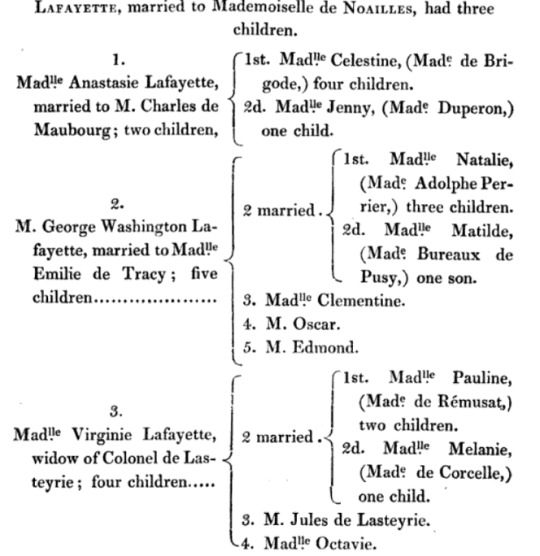
Jules Germain Cloquet, Recollections of the Private Life of General Lafayette, Baldwin and Cradock, London, 1835, p. 227.
All fine and dandy, but I was looking for more detailed information and I wanted to include the children that had already died by the time Cloquet publishes his book – I therefor made a graphic of my own. :-)
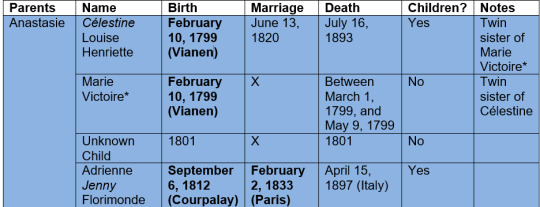
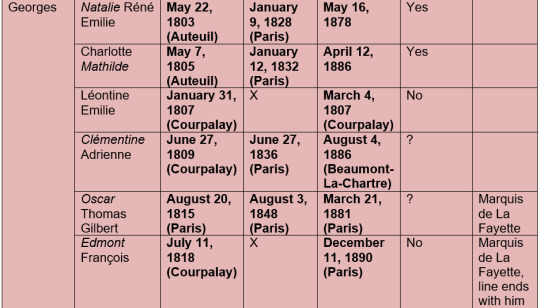
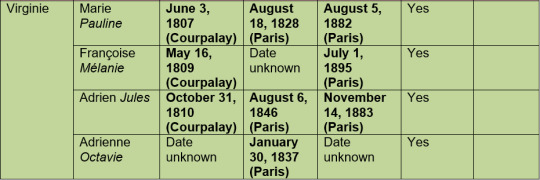
I am tempted to make one for the great-grandchildren as well, since La Fayette was very exited to become a Great-Grandfather – but this one was already a wild ride and La Fayette had more great-grandchildren then grand-children, let me tell you.
Anyway, some names are written in italics, these are the names the individuals commonly went by. I find it funny to see that all of Virginie’s children went by their second name, just like Virginie herself mostly just used her second name. Anastasie’s second child has an Asterix to her name. I have only once seen the name spelled out, on the certificate of baptism. The twins were baptized in Vianen (modern day Netherlands) and the name on the document was the Germanic spelling “Maria Victorina” – I used what I assumed is the best French spelling of the name.
The dates in bold indicate that the corresponding documentation of the birth/marriage/death can be found in the archives.
Anastasie and Charles: Finding Célestine’s dead twin sister was actually a surprise for me since I have never before seen her being mentioned. Anastasie gave birth for the first time in a town near Utrecht in what today are the Netherlands. The achieves there still have the certificate of baptism (on February 30, was the clerk sloppy or did the region in 1799 adhere to a different calendar style where February could have more then 29 days?) and we can very clearly see that there were too children. By May 9, 1799, La Fayette wrote to George Washington and referred to only one grand-child:
My wife, my daughters, and Son in law, join in presenting their affectionate respects to Mrs Washington & to you my dear g[ener]al the former is recovered & sets out for france on monday next with Virginia—our little grand Daughter [Célestine] is well, will your charming one accept our tender regard?
“To George Washington from Lafayette, 9 May 1799,” Founders Online, National Archives, https://founders.archives.gov/documents/Washington/06-04-02-0041. [Original source: The Papers of George Washington, Retirement Series, vol. 4, 20 April 1799 – 13 December 1799, ed. W. W. Abbot. Charlottesville: University Press of Virginia, 1999, pp. 54–59.] (02/12/2024)
I suspect that Anastasie had a stillbirth around August/September of 1801. La Fayette mentioned in a letter to Thomas Jefferson on June 21, 1801:
Anastasia Will Before long Make me Once More a Grand Father
“To Thomas Jefferson from Lafayette, 21 June 1801,” Founders Online, National Archives, https://founders.archives.gov/documents/Jefferson/01-34-02-0318. [Original source: The Papers of Thomas Jefferson, vol. 34, 1 May–31 July 1801, ed. Barbara B. Oberg. Princeton: Princeton University Press, 2007, pp. 403–404.] (02/12/2024)
There is no mention of this child being born and both the achieves in Paris and Courpalay yield no information so that it is unlikely that the child was born and then died young. Georges’ daughter died very young and she still is in the archives. Given La Fayette’s wording we can assume that Anastasie’s pregnancy was already somewhat advanced and the term miscarriage is only used up until the 20th week of a pregnancy, after that it is considered a stillbirth.
Georges and Emilie: The couple lost at least one daughter, Léontine Emilie, young, aged just four weeks. La Fayette wrote in a letter to Thomas Jefferson on February 20, 1807:
My family are pretty well and beg to be most affectionately respectfully and gratefully presented to you—We expected a Boy to be called after your name—But little Tommy has again proved to be a Girl [Léontine Emilie].
“To Thomas Jefferson from Marie-Joseph-Paul-Yves-Roch-Gilbert du Motier, marquis de Lafayette, 20 February 1807,” Founders Online, National Archives, https://founders.archives.gov/documents/Jefferson/99-01-02-5122. [This is an Early Access document from The Papers of Thomas Jefferson. It is not an authoritative final version.] (02/12/2024)
La Fayette later wrote to James Madison on June 10, 1807:
We Have Had the Misfortune to Loose a female Child of His, four Weeks old [Léontine Emilie]. My Younger daughter Virginia Has Lately presented us With an other infant of the Same Sex [Marie Pauline]. My Wife’s Health is Not Worse at this Moment, But Ever too Bad.
To James Madison from Marie-Adrienne-Françoise de Noailles, marquise de Lafayette, 10 June 1807,” Founders Online, National Archives, https://founders.archives.gov/documents/Madison/99-01-02-1768. [This is an Early Access document from The Papers of James Madison. It is not an authoritative final version.] (02/12/2024)
As a sidenote because it confused me while searching for the letter; the archives list Adrienne as the author. I am certain that is wrong because a) Adrienne was not corresponding with James Madison, b) this is not her writing style but La Fayette’s, c) the letter does not have her typical signature and d) there is the passage about the authors wife’s health – this one at the least gives it away.
Identifying Léontine Emilie was actually quite a bit of luck as well. I found the letter to Madison by accident and that letter is the only source that mentions her that I know of. I have never seen her in any other letters, documentation, contemporary or secondary books. The letter helped to narrow her birthday and her date of death down and with that information I searches the archives in Paris and Courpalay in the hopes of finding the child – and I was lucky. While I of course understand the order of things, it still saddens me to see that you can be born into such a prominent family – your father was a Marquis, your grand-father was the Marquis, and still, not even your families biographers care to even mention you.
Virginie und Louis: For all I know, and I again have to say that I have not nearly as much data/correspondence as I would like with regard to these topics, Virginie never lost a child. There is always the question what La Fayette would feel comfortable telling and to whom. There is also the question if La Fayette himself was always aware of everything. For example, in the case of a miscarriage very early on in the pregnancy he might have not included it in his correspondence or in fact maybe not even known himself.
As much as would wish a happy family life for Virginie, stillbirths, infant deaths and especially miscarriages were and still are not uncommon.
I have put excerpts from a few more letters by La Fayette to his American friends under the cut that help identify his grandchildren.
La Fayette to Thomas Jefferson, June 4, 1803:
I am Here, with my Wife, Son, daughter in law, and New Born little grand daughter [Natalie Renée Émilie] taking Care of my Wounds, and Stretching My Rusted Articulations untill I can Return to my Beloved Rural Abode at La Grange.
“To Thomas Jefferson from Lafayette, 4 June 1803,” Founders Online, National Archives, https://founders.archives.gov/documents/Jefferson/01-40-02-0361. [Original source: The Papers of Thomas Jefferson, vol. 40, 4 March–10 July 1803, ed. Barbara B. Oberg. Princeton: Princeton University Press, 2013, pp. 485–486.] (02/12/2024)
La Fayette to Thomas Jefferson, April 20, 1805:
Here I am with my son and daughter in law who is going to increase our family [Charlotte Mathilde]. Her father is to stand god father to the child and if He is a Boy we intend taking the liberty to give Him Your Name.
“To Thomas Jefferson from Marie-Joseph-Paul-Yves-Roch-Gilbert du Motier, marquis de Lafayette, 20 April 1805,” Founders Online, National Archives, https://founders.archives.gov/documents/Jefferson/99-01-02-1556. [This is an Early Access document from The Papers of Thomas Jefferson. It is not an authoritative final version.] (02/12/2024)
La Fayette to Thomas Jefferson, April 8, 1809:
(…) My Children are in Good Health. Two of them, My daughter in Law [Clémentine Adrienne], and Virginia [Françoise Mélanie] are Going to increase the family.
“To Thomas Jefferson from Marie-Joseph-Paul-Yves-Roch-Gilbert du Motier, marquis de Lafayette, 14 December 1822,” Founders Online, National Archives, https://founders.archives.gov/documents/Jefferson/98-01-02-3215. [This is an Early Access document from The Papers of Thomas Jefferson: Retirement Series. It is not an authoritative final version.] (02/12/2024)
#marquis de lafayette#la fayette#french history#history#letters#founders online#george washington#thomas jefferson#james madison#archieve#resources#1799#1801#1812#1803#1805#1807#1809#1815#1818#1810#georges de la fayette#anastasie de la fayette#virginie de la fayette
39 notes
·
View notes
Text
THIS DAY IN GAY HISTORY
based on: The White Crane Institute's 'Gay Wisdom', Gay Birthdays, Gay For Today, Famous GLBT, glbt-Gay Encylopedia, Today in Gay History, Wikipedia, and more … April 20



1188 – Died: St Hildegonde of Neuss (Also spelt Hildegund), German saint, biologically female, who dressed as a boy as a child, and lived as a man as an adult, before entering a male monastery. She was born at Neuss, near Cologne. After the death of her mother, at age 12, she went with her father, a knight, on a pilgrimage to Jerusalem. For her safety, during the trip, she was dressed as a boy and called "Joseph" for her protection.
While returning from the Holy Land Hildegund's father died, but she was able to make her own way home and maintained her disguise first as a boy and then as a man. Later, she made a pilgrimage to Rome, during which she had several adventures.
On one of them, she was condemned to be hanged as a robber and escaped only when a friend of the real robber cut her down from the gallows.
After that, she returned to Germany and was accepted into the Cistercian monastery at Shönau, near Heidelberg, concealing her gender, and to her death she was believed to be a man. Her true sex went undiscovered until her death in 1188.
A few years later, abbot Engelhartof Langheim wrote her biography. She is considered a saint, even though her cult is not approved by the Roman Catholic Church.


Aretino by Titian
1492 – The Renaissance writer and dramatist Pietro Aretino was born on this date (d.1556). Aretino was an Italian author, playwright, poet and satirist who wielded immense influence on contemporary art and politics and invented modern literate pornography, notably in La Cazzaria ("The Book of the Prick"). This colorful writer and dramatist, described as the first professional writer of his century, was probably the son of a cobbler, although he preferred to claim he was illegitimate and of noble origin. His patrons included Popes (Leo X, Clement VII), Cardinals, kings (Francois I and Emperor Charles V) and other connoisseurs of the porn of the age. He had a flair for self-dramatization, a fertile dirty mind, and an uncanny knack for profiting from the politics of his age. He first achieved notoriety for a series of pornographic sonnets, each describing a different position of sexual intercourse, and each illustrated by Giulio Romano and in which he declares himself to have been a sodomite from birth.
Aretino prospered, living from hand to mouth as a hanger-on in the literate circle of his patron, sharpening his satirical talents on the gossip of politics and the Papal Curia, and turning the coarse Roman pasquinade into a rapier weapon of satire, until his sixteen ribald Sonetti Lussuriosi (Lust Sonnets) written to accompany Giulio Romano's exquisitely beautiful but utterly pornographic series drawings engraved by Marcantonio Raimondi under the title I Modi finally caused such outrage that he had to temporarily flee Rome.
In 2007, Michael Nyman set eight of the poems to music. They proved no less controversial in the twenty first century: at a 2008 performance at Cadogan Hall, the programs were withdrawn on allegations of obscenity.
In a letter to Giovanni de Medici written in 1524 Aretino encloses a satirical poem saying that due to a sudden aberration he has fallen in love with a female cook and "temporarily switched from boys to girls..." Later he was known and admired for his ragionamenti dialogues, often audaciously filthy, on contemporary Roman life. Public figures so feared his clever and vicious pen that Aretino became rich from promising not to write on certain subjects. He is said to have died from a stroke while laughing at a dirty joke.
Aretino was a close friend of Titian, who painted his portrait at least three times. The early portrait above is a psychological study of alarming modernity.


1857 – Herman Bang (d.1912) was a Danish writer and one of the men of the Modern Break-Through - the late 19th century literary movement in Scandinavia that replaced Romanticism. Bang was born of a noble family on the small Danish island of Als.
When he was twenty he published two volumes of critical essays on the realistic movement. In 1880 he published his novel Haabløse Slægter (Families without hope), which at once aroused attention. The main character was a young man who had a relationship with an older woman in Danish fin de siècle society. The book was considered pornographic and immoral at the time and was banned. After some time spent travelling and a successful lecture tour in Norway and Sweden, he settled in Copenhagen, and produced a series of novels and collections of short stories, which placed him in the front rank of Scandinavian novelists. Among his more famous stories are Faedra (1883) and Tine (1889).
Bang was a homosexual, a fact which partly isolated him in Danish cultural life and made him the victim of smear campaigns. He lived most of his life with his sister but found happiness for a few years with the Hungarian actor Max Eisfeld with whom he lived in Prague 1885-86.
Failed as an actor, Bang earned fame as a theatre producer in Paris and in Copenhagen. He was a very productive journalist, writing for Danish, Nordic and German newspapers, developing modern reporting. His article on the fire of Christiansborg Palace is a landmark in Danish journalism. Some of his books, including Tine and Katinka (English titles), were translated into many languages and filmed.
Of especial interest is Michael. Michael (also known as Mikaël, Chained: The Story of the Third Sex, and Heart's Desire) was a movie released in 1924 directed by fellow Dane Carl Theodor Dreyer (director of other notable silents such as The Passion of Joan of Arc (1928)). Along with Different From the Others (1919) and Sex in Chains (1928), Michael is widely considered a landmark in gay silent cinema.
The film is based on Herman Bang's 1902 novel Mikaël. It is the second screen adaptation of the book, the first being The Wings, made eight years prior by gay director Mauritz Stiller. Michael, however, follows Bang's storyline much more closely than the earlier film version had done.
Herman Bang's last years were embittered by persecutions and a declining health. He travelled widely in Europe and died during a recitation tour in the USA.


1895 – Henry de Montherlant was a French writer of essays and novels (d.1972), as well as one of the leading French playwrights of the twentieth century.
Descended from an old noble family, he was educated at private schools at Jeanson-de-Sailly, then at the Sainte-Croix academy at Neuilly-sur-Seine, where his family lived.
Conscripted in 1916, he was wounded and decorated. Marked by his experience of war, he wrote Songe (Dream), an autobiographic novel, as well as his Chant funèbre pour les morts de Verdun (Funeral Chant for the Dead at Verdun), both exaltations of heroism during the Great War.
His early successes were works such as the tetralogy Les jeunes filles (The Young Girls) (1936-1939) and Les célibataires (The Bachelors) (1934). At this time he did a lot of travelling, mainly to Spain, Italy, and Algeria.
From 1929 he began to write for the theatre, plays such as La reine morte (1934), Pasiphaé (1936), Le Maître de Santiago (1947), Port-Royal (1954), Le Cardinal d'Espagne (1960). He is particularly remembered as a playwright. In his plays, as well as in his novels, he frequently portrayed heroic characters displaying the moral standards he professed.
In Le solstice de Juin (1941) he expressed his admiration for the German army and claimed that France had been justly defeated and conquered in 1940.
Montherlant concealed his pederastic tendencies from the public during his lifetime. In 1912, he had been expelled from the Sainte-Croix de Neuilly academy for a relationship with a fellow student. Although not openly gay, Montherlant treated homosexual themes in his work, including his play La Ville dont le prince est un enfant (1952) and novel Les Garçons (The Boys), published in 1969 but written four or five decades earlier. Les garçons and his correspondence with Roger Peyrefitte, (author of Les amitiés particulières (1943), also about sexual relationships between boys at a Roman Catholic boarding school), are the main testaments to this side of his character.
In 1960 Montherlant was elected a member of the Académie française. His presentation speech dwelt mercilessly on the geography of New Zealand.
According to Peyrefitte, some time in 1970 he was beaten up by some youths, which caused a serious injury to his eye, as a consequence of which he became progressively blind.
He committed suicide in 1972, swallowing a cyanide capsule and shooting himself in the head.

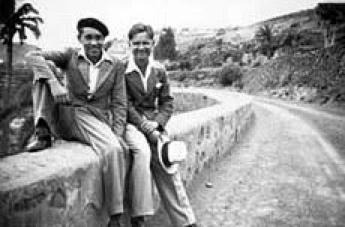
Isherwood and Neddermeyer
1914 – Heinz Neddermeyer was a German citizen considered to be the first great love of writer Christopher Isherwood.
Heinz and Christopher met in Berlin on March 13, 1932 when Heinz was 17. Christopher would often describe their relationship as an adoption, since Heinz was so much younger and not entirely mature. The couple lived together in Berlin until May 1933 when, because of the rise of Hitler, they were forced to flee the country. They traveled Europe and North Africa until May 12, 1937 when Heinz was expelled from Luxembourg and forced to return to Germany. The next day he was arrested by the Gestapo and sentenced to three and half years of forced labor and military service. He survived the forced labor which was brief. Being conditionally freed if he would take a wife, he married a woman named Gerda in 1938 and had a son named Christian, his only child, in 1940. It was not uncommon for gay men to take this drastic turn in their lives after being arrested and sentenced to prison for homosexuality by the Nazi party.
Although Heinz and Christopher continued to correspond, Heinz would not see Christopher again until November of 1952 while Christopher was visiting England and Germany for productions of his "Berlin Stories".
In November 1956 Christopher received a note from Heinz stating that he had been in a political argument at the factory where he worked in East Berlin. Fearing arrest, he fled to Hamburg. Christopher sent him some money. Nothing else is mentioned of Heinz in Christopher's diaries other than fond memories of their past in various cities around Europe and a kind note from Heinz when Christopher's mother passed away in August of 1960.
Heinz died in 1984.


1935 – Warren Casey (d.1988) was an American theatre composer, lyricist, writer, and actor. He is best known for being the writer and composer, with Jim Jacobs of the stage and film musical Grease.
In the mid-1960s, Casey met Jim Jacobs while acting with the Chicago Stage Guild, and the two began collaborating on a play with music about high school life during the golden age of rock 'n' roll in the 1950s. Entitled Grease, it premiered in 1971 at the Kingston Mines Theater, one of the pioneering companies of Chicago's off-Loop theater movement, in the Lincoln Park section of Chicago. Producers Ken Waissman and Maxine Fox saw the show and suggested to the playwrights that it might work better as a musical, and told them if the creative partners were willing to rework it and they liked the end result, they would produce it off-Broadway.
Casey quit his day job as a department store lingerie buyer and the team headed to New York City to collaborate on what would become Grease, which opened at the Eden Theatre in downtown Manhattan, moved to Broadway, and earned him a Tony Award nomination for Best Book of a Musical. The show went on to become a West End hit, a hugely successful film (for which he and Jacobs wrote additional songs), and a staple of regional theatre, summer stock, community theatre, and high school drama groups.
Casey was gay and he died of AIDS-related complications in Chicago at the age of 53. At the time of his death he was writing a musical with the Brazilian performer Valucha deCastro.


1943 – Jamie Gillis (d.2010) was an American pornographic actor, director and member of the AVN Hall of Fame.
Gillis was born James Ira Gurman in New York City into a Jewish family and graduated from Columbia University. His parents named him Jamie after the Tyrone Power character in the film The Black Swan (1942), and he took the name Gillis from the girlfriend he was living with when he made his first films.
He appeared in more than 470 movies as an actor. He also directed several adult movies. Openly bisexual, he appeared in many gay porn films, including a sex scene with Zebedy Colt in the 1975 BDSM-themed film The Story Of Joanna. Gillis also appeared in the mainstream Hollywood film Nighthawks (1981) as the boss of Lindsay Wagner's character.
He was a pioneer in the pornographic style known as Gonzo. In addition to starring in the first Buttman film, he also created the influential On The Prowl series. Featuring a porn star who rides in a limo looking for regular guys to have sex with, the video series was very popular and inspired a scene in the movie Boogie Nights. He also co-produced the popular Dirty Debutante series with fellow director and performer Ed Powers, as well as the Walking Toilet Bowl series of films that focused on golden showers and coprophilia.
Gillis died on February 19, 2010 in New York City from melanoma, which was diagnosed four or five months earlier. In an audio interview given to The Rialto Report shortly before his death, Gillis stated that in the 1970s he'd wanted his ashes to be scattered in Times Square, but years later he changed his mind as "clean Times Square would contaminate them".


1951 – The American R&B singer Luther Vandross was born on this date (d. 2005).
Initially content to remain in the background as a backing singer and producer - he toured with David Bowie in 1974 and sang backing vocals on the Young Americans (1975) album - Vandross was encouraged to take centre stage by Roberta Flack, who thought he had a unique talent. His breakthrough to major chart success came as lead singer with Change, and he went on to have a string of million selling hit solo albums, and successful collaborations with other artists, throughout the 80s and 90s.
During Vandross' entire career he was 'dogged' by questions regarding his sexuality. He never married, his name was never romantically linked in the media with women. Although Vandross never explicitly denied being gay, he never publicly acknowledged it either. He generally fielded questions by saying that his 'busy lifestyle' made marriage difficult and indicated that, in any case, 'it was not what he wanted.' Many gay publications have stated that Vandross' gayness was an 'open secret' in the music business, but even now it is rarely spoken of.
He died of a heart attack in Edison, NJ at 54. Some of his songs are: Endless Love, Always and Forever, Dance with My Father and Your Secret Love.
His unusual middle name "Ronzoni" was given him by his mother in thanks for the comfort that Ronzoni brand pasta products gave her during her pregnancy.


1959 – Douglas Sadownick is a gay American writer, activist, professor and psychotherapist. He co-created The Buddy Systems (1985) with Tim Miller, with whom Sadownick was involved in a 14-year relationship.
Born in the Bronx, Douglas Sadownick attended Columbia College for his B.A., New York University for his graduate work in English, and the graduate program in clinical psychology at Antioch University for a Master's of Arts in Clinical Psychology. He received his Ph.D. from Pacifica Graduate Institute in Clinical Psychology in 2006. His dissertation was entitled, Homosexual Enlightenment: A Gay Science Perspective on 19th Century German philosopher Friedrich Nietzsche's Thus Spoke Zarathustra.
He is the founding director of the nation's first LGBT Specialization in Clinical Psychology, at Antioch University, and he is also the Founder of Colors LGBTQ Youth Counseling Center, founded in 2011, with Philip Lance, an LGBT affirmative psychologist and community organizer. He is also a co-founding member of the Institute for Uranian Psychoanalysis , which is the first Institute in the world dedicated to deepening homosexual self-realization. He was also a principal co-founder of Highways Performance Art Space in 1989.
His work Sacred Lips of the Bronx (1994) was nominated for a Lambda Literary Award. His second book, Sex Between Men: An Intimate History of the Sex Lives of Gay Men, Postwar to Present, was published in 1996 and 1997. His articles have appeared in the Advocate, the Los Angeles Times, Genre, High Performance, the New York Native, and the L.A. Weekly. He received a GLAAD award for excellence in reporting in 1991. He works as a private practice psychotherapist in Hollywood, California.

McGehee (L) with working partner Siegel


1981 – Matus Valent is a European male fitness model born in Bratislava, Slovak Republic living in California.
As a youth, he played indoor volleyball and became the Junior Slovakian champion with his team ASK Inter. He was also on the Slovakian National volleyball team at age 19.
During his college years, he turned to beach volleyball, and in 2004 he became the California A-Category champion. After earning a University Masters Degree in Physical Education and Sports with Management in his hometown, he moved to California where he now lives.
Matus Valent has appeared in numerous magazines (over 200 in the past 8 years) including Muscle & Fitness, Fitness RX, Flex, Muscle & Performance, Iron Man and many others with over 46 covers in the USA and internationally. He also has several catalog, romance novels & fitness book covers under his belt. (Not to mention his ample goodies)
His modeling career has lead to many other opportunities for Matus, including appearing in the music video for Kristine W's hit " Walk Away," modeling for the movie poster for "Pathfinder", being featured in national advertising for Otomix fitness clothing and active wear, national TV commercial for Shake Weight, TCORE, and ORECK XL vacuums and co-starring in the third season of Janice Dickinson Modeling Agency TV series. In 2009, Matus also appeared in ad campaigns for Prosource.net and Nutrition Express supplements superstores and made appearances in the films "Night at the Museum II" and "Baggage Claim."

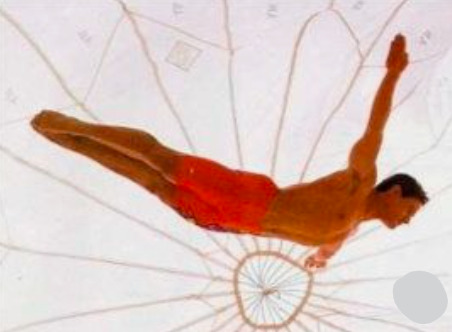
1990 – On this date Queer Nation members showed up en masse at Macy's department store where Olympic gold medalist Greg Louganis was promoting a new swimsuit line. Queers arrived with WHEATIES cereal boxes with the swimmer's picture pasted on front, to recall the time the cereal maker rejected Louganis as a spokesperson, ostensibly because he is Gay.



How to say gay in Chinese
2001 – China removes homosexuality from their list of mental disorders.
Bōlī (玻璃)
The English translation of the Chinese word bōlī (玻璃) is crystal, glass, etc., and since the mid-90s it has been used as a slang term for homosexual men by the LGBT community in China and Taiwan. This slang word comes from the English acronym B.L., which has several versions, like Boy Lover, Boy’s Love, Boys Love. All of them serve to refer to the love between boys, men, etc.

T-shirt with the bōlī (玻璃) drawing.


27 notes
·
View notes
Text

I'm a special collections/manuscript librarian in my day job, and the main collection I work with features microfilm reproductions of about half of the manuscript libraries in the Biblioteca Apostolica Vaticana. And it turns out (I didn't actually know this until I started reading Anthony Grafton's Magus) that those collections include a very important Faustian document: the correspondence of one Abbot Johannes Trithemius, another scholarly magician who in the letter shown above had just heard about a certain fellow calling himself Georg Sabellicus or Faustus junior, who was traveling around making extravagant claims (Trithemius is quoting his business card), doing horoscopes, and persuading nobles to use arsenic as hair remover. Trithemius considered himself a real magician, of course, and here he is basically complaining that Faustus Georg is giving the profession a bad name.
Grafton's chapter on Trithemius suggests that he was a pretty weird guy himself, and that his own portrayal of his abilities was pretty similar to what Faustus Georg was claiming, so no wonder he kinda took it personally. One of the anecdotes that becomes part of the legendary Faust narrative, appearing in the Spiers Faustbuch and indeed in Marlowe's Doctor Faustus--the episode in which he summons the spirit of Alexander the Great for Emperor Charles V--actually has an analogue that's attached to Trithemius, although it's a different emperor and in that story he wants to see the ghost of his wife.
The letter above is an autograph manuscript, btw--it's in Trithemius' own hand. Very Italian-style script: it's a fairly international series of letters, although Grafton suggests that portions of it are basically just made up and were never actually sent to their purported recipients. Obviously the picture is not from our microfilm!
33 notes
·
View notes
Text
Timeline 9 - August - September 2023
For completeness and to consult when there’s discussion about his whereabouts. In addition to the previous timelines.
Timeline 9 covers 2 August 2023 - 26 September 2023
For previous dates see timeline 8
2 August, this time groomed while photographed on the streets of NoHo with AN. Later on we learned he recorded videos for Esquire

3 August, the next shop event at Broadway Spirits, some more streetpics and video were found.
August 4 he flew to Chicago for the next event at Binny's Beverage Depot on August 5th. There's some time to explore Chicago in the evening and the next day enjoying a baseball game. He's also spotted by a fan leaving the hotel
Next stops will be on August 8 for Houston and August 10 for Austin. While the LA stop has been postponed.
August 7 looking for some coffee at the airport and flying to Houston. And right back to promo and mixing cocktails at Permission Whiskey and Mad Houston
August 8 the event at Spec's Wines, Spirits & Finer Foods including the pre-signing, waiting line and fan pics. After which he did some more bartending at Electric FeelGood in Houston.
August 9 he's in Austin seen at Peche, the next day, August 10, the event at Total Wine & Spirits in Austin takes place.
August 11, Sam and Alex are flying, probably to LA though it's not sure if the story is a latergram
However confirmation about his whereabouts came a week later when we saw NR flying on August 16 to what appeared to be LA and was confirmed by PV's post they were at Pharos gym at Redondo Beach on August 17th.
August 19 he visits the Rams game in the Sofi Stadium, LA together with Nic R, AN and Marina C. A fan recognized him as well.
On Aug 24th he posted a video probably at Runyon Canyon or the HH Hills. Presumably recent. The next day, August 25th, he posted a pic with NR at Pharos Echopark, for sure a latergram as NR was already back home, and as we learned S himself took a flight out of LA, spotted by a fan. He flew to Kansas City for a private con on August 26th, organised by Sasnak City. he was a guest together with Duncan L and Charles V. Some more info was revealed later during a live IG of attendees.

On Friday 1 September members of the SS/MPC team were invited for a boat trip at Marina Del Rey. Which lead to a stir since then called the Zanzibar Saga.
Sunday 3 September the final event of the SS tour at Total Wine & More in LA
On 5 September he was spotted sitting outside at Shutters on the Beach, and 2 days later on 7 September again, now at a coffee shop on Abbot Kinney same clothes and motorbike helmet.
On 10 September he's at the men's finales at the US Open in NYC
Recording the audio for the CL in NZ book at the Hachette office in NYC during the week from 11 - 15 September, on Friday 15 September a group pic from the office is posted as well as another pic from an employee. Another group pic is posted later on. On Saturday 16 September a fan pic is posted from the Starbuck shop near the Hachette office and on 18 September he posts a video himself.
Sunday 24 September he's spotted at The Cafe at Number 16 in Aberdour, Scotland, having some family time
On 26 September he posts a selfie with Jake Norton, meeting him in Glasgow the day before. Later on confirmed by a fan pic taken on the same day. He might have been doing some home decorating in that week.
Other timelines:
Pre Hawaii timeline
Timeline 1 August 2020
Timeline 2 September 2021
Timeline 3 February 2022
Timeline 4 August 2022
Timeline 5 October 2022
Timeline 6 January 2023
Timeline 7 April 2023
Timeline 8 June 2023
43 notes
·
View notes
Text
“Archaeologists are still discovering the extent of monastic skills and technological cleverness. In the late 1990s, University of Bradford archeometallurgist Gerry McDonnell found evidence near Rievaulx Abbey in North Yorkshire, England, of a degree of technological sophistication that pointed ahead to the great machines of the eighteenth-century Industrial Revolution. Rievaulx Abbey was one of the monasteries that King Henry VIlI ordered closed in the 1530s as part of his confiscation of Church properties.) In exploring the debris of Rievaulx and Laskill (an outstation about four miles from the monastery), McDonnell found that the monks had built a furnace to extract iron from ore.
…
McDonnell believes that the monks were on the verge of building dedicated furnaces for the large-scale production of cast iron-perhaps the key ingredient that ushered in the industrial age -and that the furnace at Laskill had been a prototype of such a furnace. "One of the key things is that the Cistercians had a regular meeting of abbots every year and they had the means of sharing technological advances across Europe," he said. "The break-up of the monasteries broke up this network of technology transfer." The monks "had the potential to move to blast furnaces that produced nothing but cast iron. They were poised to do it on a large scale, but by breaking up the virtual monopoly, Henry VIII effectively broke up that potential.1”
- Thomas E. Woods Jr., Ph.D., “How the Monks Saved Civilization,” How the Catholic Church Built Western Civilization
—
1. Charles Montalembert, The Monks of the West: From Saint Benedict to Saint Bernard, vol. 5 (London: Nimmo, 1896), 227.
17 notes
·
View notes
Text
a blessing, a fable
seb/charles, 6.8k, explicit, unresolved ending.
“I carry a message from the abbot of Maranello,” Brother Charles announced, voice ringing across the courtyard like a bell. He wore the short white tunic of a novice under his cloak, which was enough to set Sebastian on edge. As far as Sebastian knew, Maranello did not send initiates on missions before they had taken their full vows. There were too many temptations outside of the abbey walls, the former abbot had told Sebastian once, his mouth loose with wine and good humor.
Brother Charles would have been a temptation himself, long dark lashes sweeping across his delicately carved cheekbones. His eyes were bright and unguarded as they met Sebastian’s without a hint of fear.
#sebchal#sebastian/charles#sv5#cl16#my fic#if u see any mistakes... don't tell me... i'm on a train 😭😭😭 (actually pls do tell me)#the chigmata (charles stigmata)
9 notes
·
View notes
Photo

Alice Harriet Argyll Strachey (d.1914)
Charles Émile Hippolyte Lecomte-Vernet (1821–1900)
Abbot Hall
32 notes
·
View notes
Text

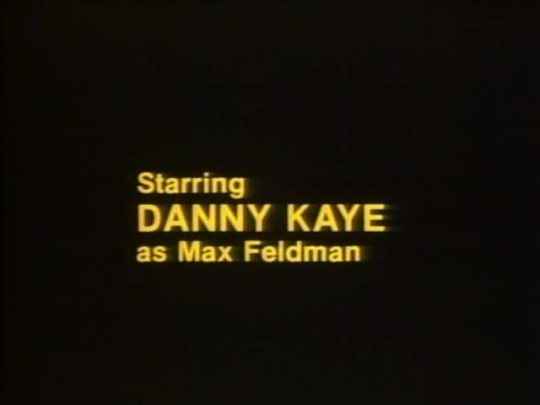














Skokie - CBS - November 17, 1981
Drama (based on fact)
Running Time: 125 minutes
Stars:
Danny Kaye as Max Feldman
John Rubinstein as Herb Lewisohn
Carl Reiner as Abbot Rosen
Kim Hunter as Bertha Feldman
Eli Wallach as Bert Silverman
Brian Dennehy as Chief Arthur Buchanan
George Dzundza as Frank Collin
Ed Flanders as Mayor Albert J. Smith
Charles Levin as Rabbi Steinberg
Stephen D. Newman as Aryeh Neier
James Sutorius as David Hamlin
Lee Strasberg as Morton Wiesman
Marin Kanter as Janet Feldman
David Hurst as Sol Goldstein
One of Danny Kaye's last performances. His dramatic portrayal of a Holocaust survivor received much acclaim.
#Skokie#TV#Drama#CBS#1981#Danny Kaye#John Rubenstein#Carl Reiner#Kim Hunter#Eli Wallach#Brian Dennehy#George Dzundza#Ed Flanders
12 notes
·
View notes
Text

On July 3rd 1449 James II took formal control of his kingdom following his marriage to Marie of Guelders, niece of the Duke of Burgundy in Holyrood Abbey.
Marie, or Mary as she became known in Scotland had been earmarked to marry Charles, Count of Maine, but her father could not pay the dowry. Negotiations for a marriage to James II in July 1447 when a Burgundian envoy went to Scotland and were concluded in September 1448. Philip promised to pay Mary’s dowry, while Isabella paid for her trousseau. Philip the Good, Duke of Burgundy settled a dowry of 60,000 crowns on his great-niece and Mary’s dower (given to a wife for her support in the event that she should become widowed) of 10,000 crowns was secured on lands in Strathearn, Athole, Methven, and Linlithgow.
William Crichton, Lord Chancellor of Scotland was sent to Burgundy to escort her back and they landed at Leith on June 18, 1449. Marie was 15 and James 19 when the two wed on July 3rd and immediately after the marriage ceremony, Mary was dressed in purple robes and crowned Queen of Scots. Consort by Abbot Patrick.
A sumptuous banquet was given, while the Scottish king gave her several presents. The Queen during her marriage was granted several castles and the income from many lands from James, which made her independently wealthy. In May 1454, she was present at the siege of Blackness Castle and when it resulted in the victory of the king, he gave it to her as a gift. She made several donations to charity, such as when she founded a hospital just outside Edinburgh for the indigent; and to religion, such as when she benefited the Franciscan friars in Scotland. The couple had six children, the oldest James, became James III.
James II died when a cannon exploded at Roxburgh Castle on August 3rd, 1460, before his death he had ordered another castle be built for his wife who was left to oversee it’s construction as a memorial to him, Ravenscraig was still being built when Marie moved into east tower. She also founded Trinity College Kirk in Edinburgh’s Old Town in his memory, she herself died and was buried there in 1483, the old Kirk was demolished, amid protests in 1833 and Marie was interred at Holyrood Abbey.
The pic is a “Tableau Vivant with the Marriage of James II of Scotland to Mary of Gelre-Egmond in 1449 by Pieter but dates to about 200 years later.
15 notes
·
View notes
Text
First of all: thank you so much to those who made nice comments about the first part of this list (right over here)! I’m glad some people enjoyed my nostalgic rambling, but much more importantly, I loved hearing your thoughts, too! I would see other fans’ own lists, so much.
So without further ado, here is the rest of:
MY TOP TEN BRINKY MOMENTS (FROM THE 1990s): #3-1

(Content warning for one kind of bad word below, and worse, I vaguely mention Cartoon All-Stars to the Rescue which...shudders.)
I remember Tom Ruegger and Peter Hastings, probably the most influential voices in creating Pinky and the Brain, saying something to the effect of, “It goes there sometimes, but we didn’t want to just do the old ‘a jerk and an idiot’ story,” several times. Although I’m actually a big fan of Abbot and Costello, Laurel and Hardy, etc. and the “Vaudeville Comic Duo” thing is indisputably the kernel this franchise grew around, in my opinion, it was deliberately grown into something more.
A while ago, I listened to an Animanicast where one of the PatB Spin-Off writers (Charles M. Howell) mentioned that he thought that Pinky and the Brain were more complex as characters than the old vaudeville duos, and even said he was getting teary-eyed thinking about the characters because they made him emotional. It’s been a while, but I remember hearing another story where one of the spin-off’s writers recounting talking to an executive with a fellow writer about the characters. Supposedly he was saying, “These two mice…they’re REAL,” and he joked that they thought the guy was maybe uuuh losing it, but said actually, he understood what he meant.
I think that’s probably why most of the Brinky moments I hold dear and remembered through the decades came from the spin-off. The og Animaniacs skits were very funny and cute, and my absolute favorite thing about them was their classic Looney Tunes short tone and sensibility. Still, their spin-off is really where the true humanity of the characters and their relationship was able to develop.
…okay, I know what I sound like, here. I don’t actually think that the show was some brilliant work of high art or anything. There are many weaknesses, it was silly and inconsistent (sometimes very much on purpose, sometimes not), it had a famously troubled production with the network not truly valuing it making these things less surprising, blah blah blah, etc. Still, all I’m saying, as I said in part one of this list, is here are the characters being more complex and unique than people might expect or than many people (including me!) usually remember.
More importantly, here’s their relationship being different than people would expect or are likely to remember, and deeper, too.
#3: “The Pink Candidate” and “Inherit the Wheeze” – Pinky Stands Up to Brain


TL;DR below, but a summary: Once the mice get fleshed out as characters, if Pinky has a problem with something that Brain says or does, he just tells him. If he doesn’t want to go along with something, he just doesn’t. Brain doesn’t attempt to “make” him, and he wouldn’t be able to, anyway.
This might seem like a strange choice. Also, full disclosure: this part is much, much more about “The Pink Candidate” just because it was (in my opinion) the much better episode over “Inherit the Wheeze,” and also because American Drug PSAs from this period in general have…real-world related issues imo. Still.

(As far as I’m concerned, above didn’t happen and was just a bad dream.)
I thought back to these when I was trying to figure out why I never really thought of Pinky/Brain as an unequal relationship, at least not in the particular way I think it might been seen as sometimes. Again, they have massive, massive issues; I think these are so obvious there’s not much purpose to my pointing them out, even. But what’s more surprising is that, even though Brain doesn’t seem to either realize or want to acknowledge this, they actually really are PARTNERS, in my opinion. At least, once their characters are properly fleshed out.
This is more depth than they had at first, while their characters were still being worked out; while it’s a great short with amazing animation, “Brain Meets Brawn” is an example of an early story where the dynamic between the two mice is more “just what you’d expect,” and I’ll be honest with you here, there are a few nice moments in the short that are big exceptions but I mostly just don’t like it! “It” being the dynamic between the mice in the short; I very, very much enjoy the short itself – just not the core relationship in it, mostly.
This brings me back to little summary I wrote before rambling. They’re partners. Brain isn’t forcing Pinky to help him take over the world. Brain wouldn’t even be able to!
“The Pink Candidate” is a really great episode for Pinky’s character, and I could go on and on about it. But it actually shows some of the nuance of Brain’s character, too, which is why put together, it shows some of the nuance in the RELATIONSHIP. I just re-watched it and was again really struck: Pinky’s even less of a frivolous doormat than I remembered, and Brain is even less dismissive or pushy. And this depth doesn’t sacrifice the show’s humor; in my opinion it’s a funny ep. – just that fact that Brain ends up on trial partly because he’s in the Splash Zone of Bil Keane’s Campaign of Vengeance against Pinky for saying that The Family Circus isn’t funny, and that that’s a REAL plot point, sends me.
By the way, Pinky’s right: The Family Circus isn’t funny. ANYWAY.

Pinky stands up to Brain (despite actually CRYING during this scene) and gives well-reasoned points for doing so. This is my favorite take on Pinky: both more aware and, yes, “intelligent” than one would think, but also genuinely a good person. One of the reasons he supports Brain’s efforts is because he thinks that Brain’s leadership genuinely would be “what’s best for the world.” If that changes, he doesn’t stop supporting Brain as a PERSON, because he loves him. But he does stop supporting his actions and he stands up to them and says exactly why.
Brain’s actions in this episode get a “condemning with faint praise” framing from me here, but actually, it really does show how different he is here from a shallow archetype. For starters the principles that Pinky gives as reasons to stand up to Brain are ones that Brain just taught him, and Brain seems to genuinely believe in them, even if he’s not practicing them. Brain actually concedes Pinky’s two points to him in their argument scene, and sincerely (if…”wackily” and not very well) tries to address Pinky’s concerns. Obviously, his idea that an absolute authoritarian dictatorship is compatible with democracy is either hilarious or scary depending on the tone of a story, but well, delusional as he is, Brain genuinely seems to think so. Brain’s response, which is basically to have a tantrum and storm off, also isn’t commendable, but by Looney Tunes standards might be downright constrained. He doesn’t belittle, threaten, lie to, or insult Pinky here. He just tells him honestly that he’s going to do it alone and walks away. That’s it.
Of course, Pinky is going to choose Brain’s friendship over the Presidency, just by itself. But again, I like how Pinky’s reasoning here is actually deeper than even just that. Pinky mentions (to the Abe Lincoln statue, lol) that Pinky is only President because of Brain. If Pinky did what they wanted him to, and claimed to not know anything about their “Take Over the World” schemes, it would be an outright lie. Pinky is only President because he knowingly was a part of one of those schemes.
Pinky’s scene in court is also great. “I take full accountability for everything that happens in my administration.” Ironically, Pinky is impeached for doing exactly what a President SHOULD do in this situation.
The little interaction between them in the courtroom scene is nice and telling. When Pinky starts to talk, Brain shouts, “Pinky, NO!” Again, you might expect him to have blamed (or at least implicated) Pinky already or want to be saved here, but he’d rather go down alone. He doesn’t want Pinky to be impacted or take any of the blame. And again I can’t stop thinking about how, though Brain is at fault for Trying to Take Over the World TM, in some ways he’s taking the fall for Pinky here because this happened because Bil Keane wanted revenge against PINKY, and again I’m sorry but The Family Circus really isn’t funny.
Pinky also responds by cutting Brain off with, “Brain, let me handle this,” which shuts Brain right up. I often think of this when people think that Pinky just had no power or say in the relationship. Pinky has lots of issues (including with standing up for himself at times), and they and his strengths are inconsistent in this comedy cartoon. But Pinky CAN advocate for himself and he CAN take charge sometimes. I mean yeah, it’s easier when you’re the President, but this is only one of the times that Pinky puts his foot down or steps up, and Brain listens to him or follows his lead.
(One other thing is Pinky is just…weird /pos. So much that others would find insufferable, he either doesn’t mind or loves, so he wouldn’t want or need to put his foot down about it.)
“Inherit the Wheeze” might be more notable in showing just how much Brain actually does value Pinky’s opinion, despite claiming otherwise: Brain actually calls off the whole plan there, and a big part of it is Pinky’s words. While he doesn’t do that in “The Pink Candidate,” the episode actually ends with Brain thanking Pinky for standing up to him, and reminding him of principles he actually does value, even if he’s incredibly, comically bad at putting them into practice (cue “What are we gonna do tomorrow night?” joke at the end).
Anyway, I could go on and on, but the point here is:
The Family Circus is not funny.

#2: “A Pinky and the Brain Halloween” – Pretty Much the Whole Thing. There.

After rambling on and on too long about the last “moment,” this one is going to be short because it’s just so straightforward. The whole episode almost feels like it’s been written to just say, in big, bold letters:
BRAIN CARES ABOUT PINKY MORE THAN HE CARES ABOUT TAKING OVER THE WORLD.
This episode just makes that incredibly clear-cut. He chooses Pinky outright over, not just losing control of the world (again, he is ACTUALLY ACTIVELY RULING THE WORLD in this episode, and he gives that up), but EVER trying to take over the world again. I think Brain has an “I can do it myself!” attitude towards taking over the world that both seems kind of admirable (see him turning down the Devi-Walt Disney, and ripping up his contract right in front of him!) and also…actually kinda also isn’t, when you think about it (more massive ego stuff at work there), and I could almost see him giving up rulership for that. So he can say he wasn’t just literally handed the world.
But it’s not JUST that that Brain is willing to sacrifice for Pinky, it’s his entire dream, and his supposed goal in life and reason for living.
It's everything.
Brain is also willing to brave He-HADES in the first place. The fact that he briefly is selfish and doesn’t rush to Pinky’s rescue immediately, again, is part of how he’s still extremely flawed in this episode; Pinky made the deal he made, in part, because Brain literally, callously called him worthless. That’s really horrible, but the sheer lengths he goes to for Pinky here show why Brain is a complex (and, imo, pretty great, all things considered) character in the spin-off. It shows how much Brain cares and can demonstrate it through his actions, he just can’t bring himself to say it out loud.
Oh yeah, Pinky also sells his soul to the Devi-Walt Disney here, and that’s NOT because he was tricked. It’s because he thinks it’s a fair trade. ☹
He thinks it’s worth it to give his best friend in the world what he wants. It’s both heartwarming and sad, like so many things about Pinky. But the end is happy: Brain shows through his actions here that Pinky’s reasoning makes no sense.
What Brain really wants is HIM.
;_;
#1: “A Pinky and the Brain Christmas” – “Dear Santa, hello, hah hah, narf...”
I know I know how shocking and original, what a surprise. OK.

So I’ve often thought that if EVERY episode of Pinky and the Brain exploded except for the Christmas special and “Bubba Bo Bob Brain,” I’d be just fine. And if I had to choose between the two, it’d obviously be this one. And honestly, kind of…yeah. If this entire franchise was nothing but a beloved, perennial family Christmas special classic and fond childhood memory that also won a flipping Emmy, I’d still love it. And pretty much, yeah.
It's all about the ending.
I don’t know what I could say about That Scene (plus the coda, where Pinky gives Brain the world ;_; ;_;) that hasn’t already been said. The performances by both Rob Paulsen and Maurice LaMarche here are brilliant, the score is excellent, and of course the rightfully famous Tokyo Movie Shinsha Co., Ltd., animation is AMAZING. Those camera shots, those pans, those tears!

LaMarche’s delivery of “I don’t care about your STUPID LETTER!” is a great moment where the show really clearly and effectively shows the difference between the mice’s for the purposes of comedy vaudeville duo banter and Brain actually being way over the line. He sounds vicious and cruel there, and it’s not funny at all.
Despite that, I always think of what Brain does in this episode. He’s actually ruling the world, albeit for a brief time, here. He has everybody in the world under his control, in part due to the Christmas special rule that for the special’s purposes everybody in the world celebrates Christmas, but anyway.
But all his does with it is to make everybody genuinely happy, while getting nothing back for himself. Not even acknowledgement. People don’t even know that Brain is why they feel like having a Merry Christmas. They just do.
In this one moment, Brain proves that he can be who Pinky believes him to be. Pinky just described him as this in his letter: someone who “only wants what’s best for the world.” In this one moment, he gives the world a very happy holiday, without getting anything for himself. He made the world a better place.
And it’s all because of Pinky.
As for Pinky’s character in this episode, there I really don’t know how to express what hasn’t already been said. This is part of what makes Pinky one of my favorite characters of all time, why I even think of him as one of the “best,” instead of just the amusing but unthinking sidekick he could have been, instead. Pinky’s letter is really quite eloquent and insightful – and well written! It shows again his utter selflessness, but also his awareness of what’s going on.
And Pinky’s not even crying because he’s mad at Brain, it’s because he’s upset with himself for not getting his letter to Santa Claus. ☹
This whole scene could easily have fallen flat. But the fact that Pinky and Brain get fleshed out into “not JUST an idiot, not JUST a jerk” is what makes this, and the other moments on this list, work for me. If they were that simple, Pinky wouldn’t have been able to write such a letter in the first place, and Brain wouldn’t have cared about it except to think it was stupid.
It’s the way that their relationship follows by not just being “jerk leader and idiot sidekick” who don’t care about, or even hate, each other like people generally expect.
Instead, they love each other. In their own way, they are a family. They come to understand each other very well. They are well aware of each other’s flaws; though Brain is absurdly overly critical and condescending about it, while Pinky wears massively thick rose-colored glasses, even Pinky can be brutally honest with Brain about his flaws (from “Hoop Schemes,” basically - Brain says, “I’m sorry I was such a jerk,” and Pinky says casually, “That’s okay, Brain. I’m used to it.”). But both of them see the good in each other, too. ( “Lets just say that your extra jumbo sized heart more than makes up for your little free sample sized mind,” a jerky way to say it? Yes. Brain’s crummy, tsundere, socially incompetent way of saying he knows that Pinky’s pretty great? Also yes.) They care each other, anyway.
That this scene works at all shows how the mice and their relationship have been expanded into something more touching and human – the heart of the show.

31 notes
·
View notes
Text
Lets talk about Purgatory... (2)
Last time, we talked about how the belief in the existence of a Purgatory, as a third realm between heaven and hell, slowly came into existence and was ultimately accepted by the Church - but it stayed a vague, undefined realm with very little canonical or official statements about it. And we were about to see how what actually TRULY helped Purgatory grow and develop itself was popular imagination, non-religious texts and other forms of art...
As a reminder, I am still following so far for these posts an article that was written by Christine Duthoit about the beliefs in the afterlife during the Middle-Ages.
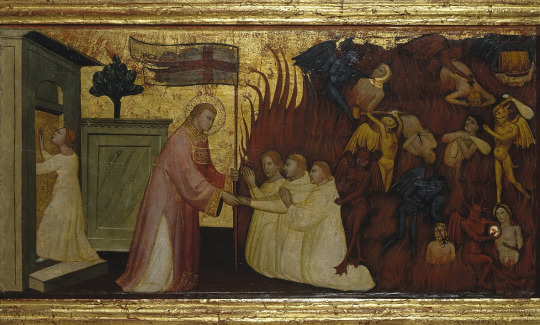
So, as we said, the fact that theologians were very vague, uncertain and brief whenever they spoke of Purgatory was a true obstacle for many artists of the time who wishe to depict this realm, and it didn't help that in the many afterlife visions they had to take inspiration from, Purgatory and Hell were clearly confused with each other, or looking extremely similar. Take the vision of Charles the Fat, in the ninth century (I briefly referenced it in the previous post). In this vision, Charles was guided by a being dressed in white, and holding a sort of shining ball emitting a strong ray of light. The guide took Charles into what is described as a "maze of hellish torments": he saw great and deep valleys of fire filled with wells in which were burning sulfur, lead, wax, soot and pitch. And in this place, souls were tortured inside boiling rivers and boling swamps ; as well as within "furnaces of pitch and sulfur, filled with great dragons, scorpions and snakes of many different species". Is it Purgatory or Hell? Hard to say. Saint Augustine was also considered to have been one of the main Christian voices behind the "infernalization" of Purgatory. And, just like with Hell, the dominating element of Purgatory is fire: descriptions are filled with fire-rings, fire-circles, fire lakes, seas of fires, walls of fire, burning valleys, hot coals, mountains of flames... However, unlike the fire of Hell which is only suffering and pain, the fire of Purgatory is meant to be purifying: it notably makes one look younger, and offers a form of immortality. This association of Purgatory with fire explains why many thought the volcanic regions were gateways to Purgatory - the Etna in Sicily, or the islands Lipari, were believed to host Purgatory. And of course, there is "Saint Patrick's well" in Ireland...
In the 12th century, four "visions of the afterlife" dominated the European beliefs and culture. Three of them are only evoked in the article but not described in details: the vison of the mother of Guibert of Nogent ; the vision of Tnugdal ; the vision of Alberic of Settefrati... As for the fourth, it is the one collected in the medieval best-seller that was The Purgatory of saint Patrick, written between 1190 and 1210. In this tale, a Cistercian monk of England named Gilbert is sent alongside a knight named Owein to build a monastery in Ireland. The story describes how the future saint Patrick, who was in the middle of Christianizing Ireland, was showed by Jesus a well... Not just any well. A round, dark and deep well located in the Red Lake (Donegal), on Station Island ; and Jesus told saint Patrick that any Christian that would spend a day and a night in this hole would be purged of all their sins - and they would also be able to see the suffering of the wicked and the joy of the virtuous. Saint Patrick had a church built nearby, and a great wall erected around the well, trusting the key of the door's wall to an abbot (mentions of this geography are found in the maps of Topography of Ireland by Giraud the Welsh). Owein, the knight, decides to go down the well, despite him having quite a handful of sins weighing his souls, and despite the warning of the churchmen that guard the well. As soon as he gets down into the hole, he is harassed by numerous demons, and forced to walk in a mix of pure darkness and red lights, filled with tormented screams and fetid smells. The red lights come from the flames of a pace that looks like Hell - and is inhabited by dragons, snakes and toads that constantly torment the souls there. Owein sees people being crucified with red-hot nails, being tied up to fiery wheels, being roasted or hanged by iron-hooks, he even sees people being plunged in huge vats of molten metal... Owein manages to face all the horrors and trials of what he beleves is Hell, by constantly invoking the name of Jesus to protect him. He ends up arriving in what seems to be Earthly Paradise, and is there welcomed by two archbishops... Who reveal to him it wasn't Hell at the bottom of the well. But Purgatory, explicitely referred to as the "third realm" of the afterlife, and where the souls of the sinners complete their repentance and purification. Once the souls of Purgatory are done with their torments, they will reach the Earthly Paradise, and then finally move on to the celestial Heaven. The knight returns to the top of the well, and upon reaching back the world of the living is glad to learn he has been purified of all of his sins.
This story became MASSIVELY popular in medieval Europe - notably because it confirmed what many people wanted to believe into, the idea that the justs and good people had a chance to completely and utterly purify themselves before reaching Heaven. By extension, it meant there were indeed various types and categories of sins, and that not all crimes were as bad - with some sins being forgivable and not preventing one's reach of Heaven...

Another key feature to understand the "creation" of Purgatory in the Christian world is the idea that the dead and the living are somehow tied to each other.
The article begins by the "communion of the saints". This belief did not originate in any actual council or official Church decision - rather, in France, it spontaneously appeared at the end of the 4th century among the Christian communities. The saints weren't just protecting and watching over the living anymore ; now, they formed a bridge and a link between the living and the dead. Most importantly, the sufferings and pains of the dead in the afterlife could be eased or shortened by the prayers of the living - through the saint, that received the prayer, and then influenced the fate of the deceased. (In France we call those interventions for the dead caused by the living's prayers "suffrages").
The apparition of the idea that the prayers of the living influenced the afterlife was part of a wider movement in Christianity that focused more and more about the dead. Take the apparition of All Hallows Day, or All Saints Day. It was created in 610 by Boniface IV, and it was originally the day of the martys - and solely the martyrs. But then it became the day to celebrate all of the saints, martyrs or not martyrs - and Gregory the IV insisted on this day being celebrated by all Christians, showing the importance it grew. In parallel, we know that as early as Gregory the Great's time, masses and religious celebrations included a "Mementa", a part to remember the dead. This expanded into the monks creating "Libri Vitae", to register all the livings and the dead that were named during a mass ; and soon necrologies and obituaries were formed, lists and registers of the deads, their names, the day they died, and their "obit", the anniversary of their deaths. And between 1024 and 1033, a Day of the Dead was created to honor and commemorate all the dead Christians... And it was placed on the second day of November, that is to say the day following All Hallows Day/All Saints Day, further strengthening the bond between the Saints and the Afterlife.
As new conceptions of sin and penitence appeared, as the confession became one of the most important rituals in the life of the Christians, stories and testimonies of deceased coming back to visit the living (usually souls from Purgatory) started multiplying. You had dead people visiting their family to demand their prayers and their memory in the afterlife ; you had dead churchmen or churchwomen informing the people of their order of what happened to them in the afterlife ; mystics and saints kept being visited by ghosts and revenants left and rights. This was a good bulk of the story of hauntings in the Middle-Ages. A greater focus was put on the idea that a Christian had to absolutely purify themselves when alive to avoid the torments of the afterlife - notably through contrition, confession and penitence. The pope Innocent III had a very cynical take on the mental beliefs and evolutions of his time, pointing out that the living only cared for the dead, because they themselves were future dead. Aka, this obsession with Purgatory and ghosts and praying for the dead was simply the other side of the coin of the fear of mortality, and the terror of the trials awaiting beyond.

In the middle of the 13th century, when it came to Churchmen that took care of the fidels and shared their daily life, the Cistercians were replaced by the Mendicant orders, the "begging monks", who were especially popular/influental in urban areas. One of the specific traits was a heavy use of "exempla" during their preach: the "exemplum" is, as the name indicates, an example, the illustration of an affirmation or claim, taking the shape of a small story. It ranges from the parable to the fable, passing by actual ancestors of what we know today as "fairytales". And it is within these exempla that the legend of Purgatory ended up being built (a good example of the results of this "exampla-fashion" is the Golden Legend, La Légende Dorée of Jacques of Voragine).
A man the article speaks heavily about is the Dominican named Thomas of Cantimpré. He was a general-preacher for a monastical province that covered a part of Germany, a part of Belgium and a part of France. After spending thirty years preaching and teaching Christianity, he collected an enormous amount of exempla in his "Livre des abeilles", The Book of bees - and this collection testifies the strong anguish and terror Christians felt at the time when it came to death and the afterlife. They also record how comforting and beloved the idea of the "suffrages", of the power of the living over the fate of the dead, was. Thomas of Cantimpré notably classified six types of "suffrages" that could ease the pain or shorten the torment of the souls in Purgatory: tears (crying for the dead), the wakes (watching over the deceased), fasting (respecting a funeral fast), alms (aka giving money to someone who will think about/pray for the dead), the "sacrifice of the mass" (aka having a funeral mass for the dead), and giving back money (aka, either paying the debts of the deceased, either restituting goods or wealth that the dead stole). This belief was certainly influenced by how Thomas of Cantimpré wrote an official biography of saint Lutgarde of Tongres, a cistercienne nun who devoted her entire life to the souls of the Purgatory, constantly praying and fasting for them.
The article offers a selection of the Purgatory-exempla that Thomas of Cantimpré wrote down.
A) A very sick man prays God so he can be set free from his ill body by death. An angel appears and offers him a choice: either be sick for a whole year and go directly to Heaven, or die now and spend three days in Purgatory. The sick man says he prefers dying now and suffering Purgatory: he dies and finds himself in the middle of cruel torments. After one year of torture, the angel comes back to him and asks him "Do you think you made the right choice?". As the soul of the dead complains about his situation, the angel reveals to him this one year... was actually one day in Purgatory. The dead man eventually agrees to take the other option - he is sent back into his sick body, and suffers his illness for one more year before going to Heaven.
B) A wealthy and powerful duke decides to convert himself to Christianity. He stops spending too much, he is very charitable to the poors of his domain, he has chapels built to celebrate masses "in honor of the souls suffering in Purgatory". The devil, angry at this, causes a rebellion and uprising among the duke's vassals. They accuse their lord of believing imaginary stories, of spending his money in a "dishonorable" way, and to not care about the noble serving under him anymore, giving all his wealth to the dead rather than the livng. This becomes a civil war, but the battle is ultimately won by the duke because he is helped by a celestial army coming down from Heaven - and made by all the souls that could escape Purgatory thanks to the duke's alms and masses.
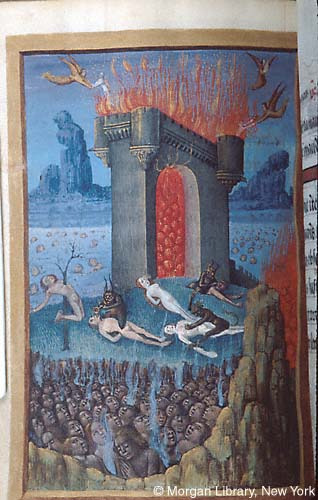
The "officialization" of Purgatory only appears with the second Council of Lyon, organized in 1274: it is then that the Purgatory became an official belief of the Christian Church. The Purgatory is seen as an extension or substitution to the earthly penitence of the living. It is stated that the duration of a stay in Purgatory depends from person to person - but that it does not have to cover all of the span between someone's death and the resurrection at the end of times (aka, a Purgatory soul can reach Heaven before Judgement Day). Starting from this Council onward, theologians started making complex and fascinating calculations in order to determine how long exactly a soul has to stay in Purgatory, depending on the quantity and gravity of the person's sins.
And with any religous process that involves the metaphysical equivalent of math tests... cheating arrived. In the form of "indulgences". For those of you not familiar with this, the system of indulgences within the Christian Church (Catholic branch) is, as the name says, a system of "pardons" and "leniences" - it is when a Catholic religious authority deserves a form of "pardon" for the sins of a specific person. At first it was another way for living Christians to purify themselves before their death - and it quickly became one of the most famous corruptions of the Church, denounced as much by Protestants as by poets such as Dante. Sinners just had to "buy" an indulgence by giving enough money to a religious authority, and they were cleansed of their crimes in the eyes of the Church - even if they made no effort to redeem themselves, underwent no penitence or did not express any regret. But by the hubilee of the Church in 1300, the Pope Boniface VIII extended the indulgences to the souls of Purgatory - which by the time had become a full part of the Christian art and Christian rituals.
And when Protestantism arose, the Catholic Church held tightly onto the belief in Purgatory: in the 16th century, the Council of Trente confirmed once more that Purgatory was part of their canon and dogma, to better differentiate Catholics from Protestants.
Fascinatingly however, it was not the first time Purgatory served a political purpose... Long before Protestanism appeared, Purgatory had been used as a tool against all those seen as dissidents groups within the Church - aka, heretics. In France, the two most famous heresies of the Middle-Ages firmly rejected Purgatory as a whole. One was the one we called the "vaudois", part of the Vaudois movement (also called Valdeism or Valdism). They held the belief that faith was a gift from God, and that by extension only the Christ could intercede. As in, only prayers to the Christ had any power to change the fate of people or could be able to reach God - by extension, they considered that the saints were powerless, and the indulgences worth nothing. Recognizing only two sacraments as "real", the Baptism and the Eucharist, they considered Purgatory to be a pure fiction, a made-up fairytale with no real existence: for them, there is only Heaven or Hell.
The other group were, of course, the Cathars, who believed that material world was inherently evil and that humans were fallen angels trapped in bodies of flesh. They only recognized one sacrament, the "consolamentum", the only ritual that can grant salvation by setting free the divine part of the human: the spirit returned to God, leaving behind its material body and the evil within it. This ritual, called a "baptism of spirit and fire" was a cross between the "last rites" for the dead (as it was the final ritual ensuring salvation after death), and an ordination, as it was the only ritual needed to become fully and "truly" Christian. Hence why the Cathars called themselves the Perfects, the Good Men or the Good Women (they also heavily used the Gospel of John, which fitted the most their beliefs). As a result of all this - for them death, like with the vaudois, could only lead to Hell (being trapped in the material world) or Heaven (becoming a pure spirit with God) - no in-between was possible.
A third group deemed as heretical by the Church that also rejected Purgatory were the Brothers and Sisters of the Free-Spirit, the Libre-Esprit movement, who preached and swore only by poverty. For them, it was poverty that set a man free of his sins and "resurrected the Christ within him". Long story short: as long as you were poor, you could listen to your every desires and follow your every whims without fearing a sin. This was the teaching of the "free-spirit": you could obtain paradise by simply living on earth, as long as you were poor, since poverty annihilated all sins. In their own words, a poor whore was worth more than a pious and just rich man - and in turn, this allowed them to declare all Churchmen were damned (denouncing how the Church had become one the wealthiest institutions of the Middle-Ages).
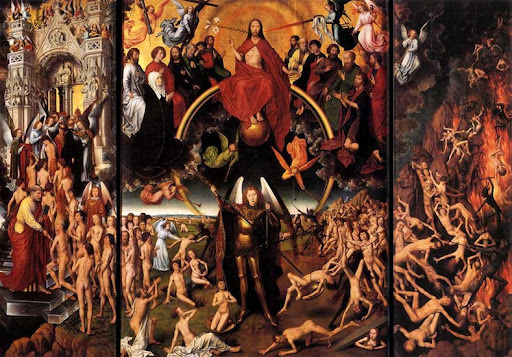
This is all I can take from the article - and unfortunately it is quite limited, since the text is about Purgatory in the Middle-Ages, and so it does not expand to modern days... But I hope it was interesting eough as a quick overview! If I find more sources, I'll continue this series.
#purgatory#christianity#christian mythology#christian afterlife#history of christianity#heresies#heresy
4 notes
·
View notes
Text
THIS DAY IN GAY HISTORY
based on: The White Crane Institute's 'Gay Wisdom', Gay Birthdays, Gay For Today, Famous GLBT, glbt-Gay Encylopedia, Today in Gay History, Wikipedia, and more …


1660 – Cardinal Francesco Maria de' Medici, was born in Florence, the son of Grand duke Ferdinando II of Tuscany and Vittoria Della Rovere (d.1711).
In 1683 he was appointed to governor of Siena, a position he maintained until his death. He was the grand prior of the Sovereign Order of Malta in Pisa; Abbot commendatario of S. Galgano, Siena; Abbot commendatario of S. Stefano, Carrara, 1675.
According to a family tradition was promoted to the cardinalate at a young age in 1686. He remained in Florence, in his villa of Lappeggi, devoting himself to a life not really religious, made of amusements and love affairs with men.
He resigned the cardinalate on June 19, 1709 and was named prince of Siena. He then was forced to marry in 1709 Eleonore Luisa Gonzaga, duchess of Guastalla, daughter of Vincenzo Gonzaga, in an attempt to save the dynasty, but they did not have children.


1746 – Jacques Charles (d.1823) was a French mathematician and inventor, best known for his work with the hydrogen balloon.
Jacques was the only child of his parents. Jacques' education consisted of basic arithmetic , and no science at all. Other than this almost nothing is known about his earlier years.
Late in life Jacques married a creole woman, Julie Françoise Bouchaud des Hérettes, who was 37 years younger than himself. Many historians believe that his marriage was a cover up for his homosexual relationship with the poet, Alphonse de Lamartine.
In 1785 Charles became a professor at the French Académie des Sciences without having any formal science education himself.
Without Charles's contributions, the Hindenburg would not have even existed, so that accident would not have occurred, and we wouldn't have the one-way valve, or at least until someone else came up for the idea after Charles did.
Most notably Jacques Charles is known for the Hydrogen balloon which he built with the Robert Brothers. Jacques originally got the idea for using hydrogen gas as a lifting agent after intensive study of Boyle's Law. Previous to the use of hydrogen gas, hot air was used to make balloons fly.
Charles also is known for the invention of the gas valve, which he used on his hydrogen balloons, the hydrometer, and the reflection goniometer. He improved the heilostat and the arometer. Charles also confirmed Benjamin Franklin's electrical experiments. Charles is also responsible for Charles's Law, but did not publish it. It was published by Joseph Gay-Lussac in 1802, and Joseph named it in Charles's honor, crediting an unpublished work by Jacques Charles.
Jacques Charles outlived his young wife, and later died himself April 7, 1823 in Paris.


1915 – Roland Barthes (d.1980), a French semanticist, symbolist, and philosopher, like André Gide and Marcel Proust, two of his favorite writers, was somewhat of an outsider. He was Protestant. (France is predominantly Catholic.) He was left-handed. (France is, of course, predominantly right-handed.) He was déclassé. (Barthes's father, a naval officer, died in the First World War, and his mother had to work as a bookbinder.) He was consumptive. (Barthes spent several years in sanatoria.) And he was expatriate. (Barthes spent the 1950s in the Middle East and Eastern Europe, working for cultural services.) He was also, like Proust, (if not like Gide, who saw himself as a pederast), a homosexual.
Barthes's critical writings are best understood in relation to this sexual marginality. Because Barthes sees homosexuality, and for that matter any transgressive and eccentric "perversion," as unclassifiable, he rejects the classification "inversion" as inaccurate—a notion that will come as a surprise to gays and lesbians who see themselves as "inverts."
Oddly enough, Barthes does not reject every gay male stereotype. Barthes rejects sexual inversion, but embraces "tricking" and "cruising," activities that he claims represent true sexual liberation. (Not that they did so for Barthes himself; his autobiographical texts suggest he had an unhappy love life.) Cruising, he writes, is "anti-natural, anti-repetition." It may be that Barthes is simply "protecting" his sexuality here (something he feels all writers do), or at least the macho ("phallocentric") part of his sexuality because whereas sexual inversion feminizes gay men, cruising for tricks is a rather manly (and purportedly desirable) thing to do.
Barthes sees tricking and cruising as desirable in another sense as well. The trick, he writes, "is homogenous to the amorous progression; it is a virtual love, deliberately stopped short on each side, by contract." Likewise, men cruise with "the invincible idea that one will find someone with whom to be in love." Some gays (who cruise for sex, not love) will find these descriptions unrealistic. Barthes, however, feels that sentimentality, in an age such as ours in which love doesn't make too much sense, is essentially—and even nonparadoxically—insignificant.
According to Barthes, "it is Western discourse as such" —discourse that marginalizes and stereotypes gays and lesbians—" that we must now try to break apart."


1946 – James F. Amos is a retired United States Marine Corps four-star general who served as the 35th Commandant of the Marine Corps. As a Naval Aviator, Amos commanded the 3rd Marine Aircraft Wing during the Iraq War in 2003 and 2004. He served as the 31st Assistant Commandant of the Marine Corps. He is the first Marine Corps aviator to serve as commandant.
As Commandant, Amos opposed the repeal of the "don't ask, don't tell" policy regarding homosexuals openly serving in the U.S. military. After President Obama signed the legislation setting the conditions for repeal, Amos led the Department of Defense in carrying out the will of the nation's civilian leadership. In late November 2011, Amos stated that his opposition to gays openly serving in the military has proven unfounded and said that Marines have embraced the change, describing the repeal as a "non-event."
1947 – A New York appellate court overturns the sodomy conviction of a "man of education and culture" accused by a mentally retarded vagrant, thus showing class bias.


1958 – Eric Marcus, born in New York City, is an American non-fiction writer. His works are primarily of LGBT interest, including Breaking the Surface, the autobiography of gay Olympic diving champion Greg Louganis, which became a #1 New York Times Bestseller and Making History: The Struggle for Gay and Lesbian Equal Rights, 1945-1990, which won the Stonewall Book Award. Other topics he's addressed in his writing include suicide and pessimistic humor.
Marcus received his B.A. from Vassar College in 1980 where he majored in Urban Studies. He earned his Master's degree from Columbia University Graduate School of Journalism in 1984 and a Master's degree in real estate development in 2003, also from Columbia University. He was an associate producer for Good Morning America and CBS Morning News.
Eric Marcus is the American Foundation for Suicide Prevention’s Senior Director for Loss and Bereavement Programs. He wrote his best-seller Why Suicide? in order to come to terms with his own father's suicide when Eric was twelve years old.
Other popular works include What If Someone I Know Is Gay? Answers to Questions about What It Means to be Gay and Lesbian, and The Male Couple's Guide: Finding a Man, Making a Home, Building a Life.


1970 – Craig Parker, born in Suva, Fiji, is an actor from New Zealand, known for his roles as Haldir in the films The Fellowship of the Ring (2001) and The Two Towers (2002), Darken Rahl in the television series Legend of the Seeker, Stéphane Narcisse in the CW television series Reign, and Gaius Claudius Glaber in the television series Spartacus.He also serves as narrator for New Zealand documentaries. Parker starred in the TVNZ soap Shortland Street, as Guy Warner, a character that has made several return appearances, most recently involving a story where Guy ran off with his brother's wife, Toni, only to return months later as a drug addled loser who attempted to use his daughter to score drugs for him. It ultimately led to the death storyline of Toni Warner. He is the reigning champion of New Zealand's Celebrity Joker Poker.
Parker first publicly discussed being gay in an interview with New Zealand’s Sunday Herald back in 2008. Regarding his sexuality, the very private Parker told the reporter that as a gay man, he doesn’t care what people say about his sexuality and that:
It’s jut not an issue for me. I just don’t get why an actor would want to reveal their secrets, hopes and fears to a magazine or newspaper. I know what the magazine gets out of it, but not the person. If you are doing publicity to increase your self-confidence then you are really in trouble. It’s important to keep some privacy. Your friends and family are the people you reveal yourself to. They are the ones who should have real access to you.


1980 – James Ryan Clabots , best known as Jimmy Clabots, is an American physical therapist, actor, and screenwriter. In 2009 he became a male escort, and retired in 2012. Since 2014 he’s been working as a writer and physical therapist in Los Angeles.
In 2000 he became a model. In 2008 Clabots started his career as an actor in the comedy film Another Gay Sequel: Gays Gone Wild!. In 2011 he starred in Showtime's Gigolos, showing male escorts in Las Vegas, but left the show in 2012 when he retired from escorting.

Clabots is of Cuban and Spanish descent.

1964 – The first depiction of a same-sex relationship is found in an Egyptian tomb. Nyankh-khnum and Khnum-hotep are discovered buried together side by side. The wall art shows the two men kissing. They were ancient Egyptian royal servants. They shared the title of Overseer of the Manicurists in the Palace of King Nyuserre Ini, sixth pharaoh of the Fifth Dynasty, reigning during the second half of the 25th century BC. They were buried together at Saqqara and are listed as "royal confidants" in their joint tomb.

The Embrace of Niankhkhnum and Khnumhotep


7 notes
·
View notes
Text

SAINTS AND MARTYRS for September 26
STS. COSMAS AND DAMIAN, MARTYRS, Being Christians, they were filled with the spirit of charity and never took money for their services. At Egaea in Cilicia, where they lived, they enjoyed the highest esteem of the people. When the persecution under Diocletian broke out, their very prominence rendered them marked objects of persecution. Being apprehended by order of Lysias, governor of Cilicia, they underwent various torments about the year 283. Their feast day is September 26th. They are patron saints of pharmacists.
St. Noel Roman Catholic Jesuit Martyr in 1643 was sent as a missionary to the Huron Indians in New France. He became assistant to Father Charles Garnier at the Indian village of Etarita in 1649 and was murdered on December 8 by an apostate Indian while returning from a visit to neighboring Ste. Marie. He is one of the martyrs of North America. Feastday Sept 26th.
ST SENATOR, MARTYR OF ALBAN
S. NILUS, ABBOTT, FOUNDER OF THE EXARCHIC MONASTERY OF SANTA MARIA IN GROTTAFERRATA, Nilus was born in 910 in the town of Rossano in Calabria. He was a Basilian monk, and then began to live the life of a hermit, dedicated to prayer and study. Toward the end of his life, he founded the famous Abbey of Grottaferrata, and became its first abbot.
St. Colman of Elo, 612 A.D. Abbot and bishop, also called Colman Lann Elo. He was born circa 555 at Glenelly, Tyrone, Ireland, the nephew of St. Columba, In 590 A.D.; he built a monastery at Offaly. He also founded Muckamore Abbey and became bishop of Connor. Colman was the author of the Alphabet of Devotion. He died at Lynally on December 26.
St. Meugant, 6th century. Hermit of Britain. Also called Maughan, Mawghan, and Morgan, he was a disciple of St. lIltyd and reportedly died on the island of Bardsey. He is the titular patron of churches in Wales and Cornwall.
4 notes
·
View notes
Photo


Saint Anthony, Abbot and Saint by Niccolo di Tommaso, 1371
Photos by Charles Reeza - Capodimonte Museum, Naples
40 notes
·
View notes
Text
130 Years of Zen in America
On this day in 1893 the World’s Parliament of Religions opened in Chicago. A subsidiary effort of the World’s Colombian Exposition (aka the “Chicago World’s Fair”), the Parliament was organized in large part part by the Swedenborgian layman Charles C. Bonney.
Among other things, the Parliament served as a substantial introduction of Eastern religion and philosophy to the west, with Swami Vivekananda offering a powerful address as a member of what he’d call one of the world’s “oldest orders of monks,” as a representative of the Hindu Vedanta tradition, introducing the dharmic traditions to America for the first time.
Importantly for me, and many of my colleagues, this event 130 years ago today also served as the formal date of introduction of the Zen Buddhist tradition to the West with “the Right Reverend Abbot” Soyen Shaku contributing as a representative of the Rinzai school (Soyen would return to America in 1905 and introduce the practice of koan zen to the west, with the teaching of Mrs. Alexander Russell). The Soto school would not formally land on American shores until the arrival of the Reverend Hosen Isobe in the early 1920’s, followed by Soyu Matsuoka Roshi in 1930, Taizan Maezumi Roshi in 1956, and Shunryu Suzuki Roshi in 1959.
Despite the socio-religious associated heinous events that would occur on September 11th 2001, 108 years later, the World’s Parliament of Religion served as an early vision of how the world could be, should we take time to see and hear one another instead of resigning to othering those who look or think differently than we do.
~Sunyananda
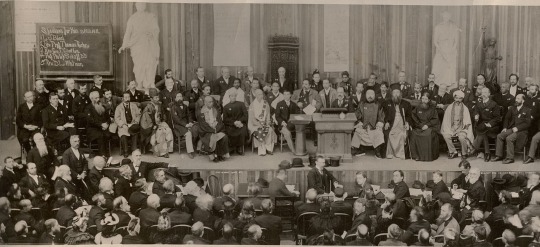
#zen#buddhism#buddha#buddhist#dharma#enlightenment#sangha#awakening#nirvana#spirituality#chicago world's fair#spiritual#American Buddhism
3 notes
·
View notes